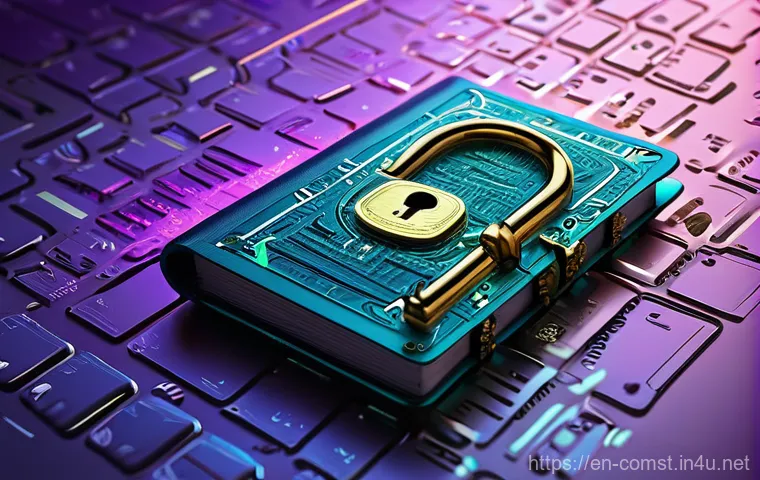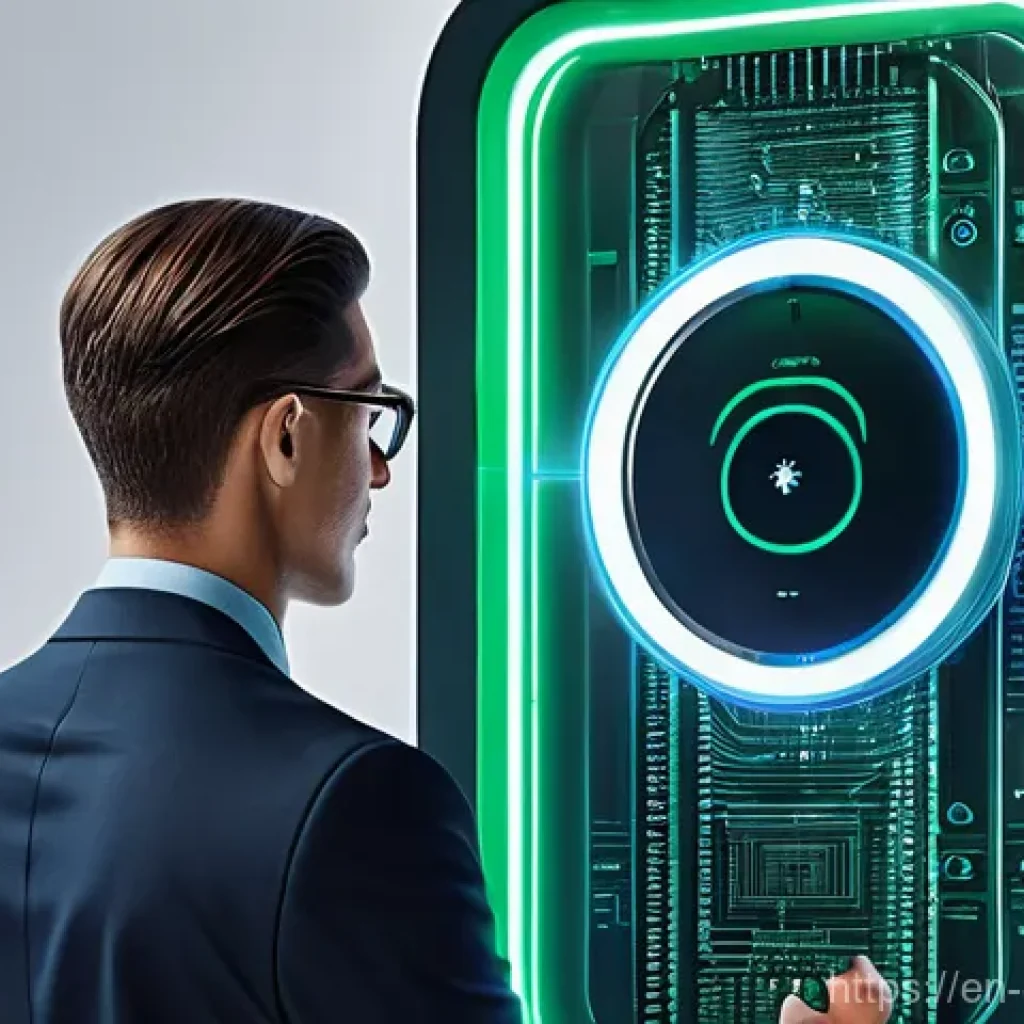Ever feel like you’re constantly playing a high-stakes game of digital whack-a-mole, trying to keep your data safe from the latest online threats? Believe me, I know the feeling.
It seems like every week there’s a new headline about a major breach or a clever new scam. We all want to feel secure in our online lives, whether we’re shopping, working, or just catching up with friends.
That’s why understanding the ins and outs of advanced security isn’t just for tech gurus anymore; it’s a critical skill for everyone navigating today’s digital landscape.
If you’ve been wondering how to really fortify your digital fortress beyond the basic antivirus, then you’re in the right place, because I’m here to spill the tea on some game-changing strategies.
Let’s explore this in detail, and I promise you’ll walk away with some actionable insights! Ever feel like you’re constantly playing a high-stakes game of digital whack-a-mole, trying to keep your data safe from the latest online threats?
Believe me, I know the feeling. It seems like every week there’s a new headline about a major breach or a clever new scam. We all want to feel secure in our online lives, whether we’re shopping, working, or just catching up with friends.
That’s why understanding the ins and outs of advanced security isn’t just for tech gurus anymore; it’s a critical skill for everyone navigating today’s digital landscape.
If you’ve been wondering how to really fortify your digital fortress beyond the basic antivirus, then you’re in the right place, because I’m here to spill the tea on some game-changing strategies.
Let’s explore this in detail, and I promise you’ll walk away with some actionable insights!
Guarding Your Gates: Beyond Basic Passwords

Okay, let’s be real. We all know we *should* have strong passwords. But how many of us actually do, and more importantly, how many of us are still using that one password across five different sites? Guilty as charged, I used to be right there with you, thinking my complex pet-name-plus-birthday combo was hacker-proof. Then I had a minor scare, a login attempt on one of my lesser-used accounts, and it was a wake-up call. Relying solely on a complex password, even a good one, is like trying to protect a fortress with just one very sturdy door. It’s good, but it’s not enough in today’s digital landscape. We need layers, a digital moat, drawbridges, and guards standing watch. This is where advanced authentication methods come into play, turning your flimsy digital key into an impenetrable security protocol. It’s about creating a unique digital fingerprint that’s incredibly difficult for anyone else to replicate.
Embracing the Power of Multi-Factor Authentication (MFA)
If you’re still just using a password, you’re missing out on the easiest and most effective security upgrade available. Multi-Factor Authentication, or MFA, is your best friend here. It’s not just about a code sent to your phone anymore, although that’s a great start. I personally use an authenticator app like Google Authenticator or Authy for almost everything important. The way it works is brilliant: even if someone somehow gets your password, they still need that second piece of information – the rotating code from your app, a fingerprint scan, or a USB security key – to get in. It adds a crucial hurdle that most attackers simply can’t clear. Think of it as having a second, secret lock on your door that only you can open, even if a thief picked the first lock. The peace of mind I get knowing that my main accounts are protected by MFA is immense, and honestly, setting it up usually takes just a few minutes.
The Unsung Heroes: Password Managers and Security Keys
Speaking of multiple factors, let’s talk about password managers. If you’re not using one, you’re doing yourself a disservice. I’ve been a loyal LastPass user for years, but there are plenty of excellent options like 1Password or Bitwarden. They generate incredibly complex, unique passwords for every single site, store them securely, and even autofill them for you. No more trying to remember “password123!” or variations of it. And for those truly critical accounts, like your email or banking, consider a hardware security key like a YubiKey. These little USB devices provide a physical, unphishable second factor that’s virtually impossible for cybercriminals to compromise remotely. I keep mine on my keychain, and while it might seem like overkill to some, for me, it’s an essential part of my digital defense strategy, especially when dealing with financial transactions or sensitive client data.
Your Digital Armor: Why Encryption Isn’t Just for Spy Movies
Remember those old spy thrillers where secret agents would encrypt their messages, making them look like gibberish to anyone else? Well, that technology isn’t just for clandestine operations anymore; it’s a fundamental part of keeping your everyday digital life secure. For a long time, I thought encryption was something only governments or huge corporations needed to worry about. But after learning a bit more about how easily data can be intercepted, especially on public Wi-Fi or if a device is lost, I quickly realized how vital it is for all of us. Encryption is essentially scrambling your data into an unreadable format, and then unscrambling it only with a specific key. It’s like putting your private diary in a locked box, and only you have the key. Without that key, all anyone sees is a jumble of meaningless characters. It’s the ultimate way to ensure that even if someone gets their hands on your data, they can’t actually *read* it.
Full Disk Encryption: Your Device’s Silent Guardian
Have you ever thought about what would happen if your laptop or smartphone got stolen? Beyond the panic of losing the device itself, there’s the terrifying thought of all your personal data, photos, documents, and financial information falling into the wrong hands. That’s where full disk encryption comes in. Most modern operating systems like Windows (with BitLocker) and macOS (with FileVault) offer this built-in. I made sure to enable FileVault on my MacBook Pro the day I got it, and honestly, it’s one of those “set it and forget it” security features that gives me incredible peace of mind. If my laptop is ever lost or stolen, I know that even if someone manages to bypass my login screen, the actual data on the hard drive remains encrypted and inaccessible without my decryption key. It’s an invisible shield, constantly protecting your entire device without you even noticing.
Securing Your Communications: Encrypted Messaging and Email
Beyond your devices, what about your conversations and emails? It’s easy to assume that our online chats are private, but without encryption, they’re often not as secure as you might think. I started switching to end-to-end encrypted messaging apps like Signal for sensitive conversations with friends and family a few years back, and it’s been a game-changer. The beauty of end-to-end encryption is that only the sender and intended recipient can read the messages; not even the service provider can snoop. Similarly, while standard email isn’t inherently encrypted, services like ProtonMail offer encrypted email accounts, or you can use browser extensions that add encryption layers to regular email. It’s about taking control of your communication privacy and ensuring that your digital whispers remain just that – whispers meant only for the intended ears.
Navigating the Wild West: Mastering VPNs and Secure Browsing
The internet can often feel like the Wild West, a vast, exciting, but sometimes dangerous place where you need to be constantly aware of your surroundings. For years, I just assumed my home internet was perfectly safe, and that any website I visited was fine as long as it looked legitimate. That illusion shattered when I started traveling more and realized how vulnerable I was on public Wi-Fi networks. Suddenly, every coffee shop, airport, and hotel lobby felt like a potential minefield for my data. This is where tools like Virtual Private Networks (VPNs) and secure browsing habits become less of a luxury and more of an absolute necessity for anyone serious about their online safety and privacy. They create a protective tunnel around your online activity, shielding it from prying eyes and potential threats.
The Indispensable VPN: Your Internet’s Private Tunnel
If there’s one tool I recommend everyone use, especially when you’re out and about, it’s a good VPN. I’ve been using NordVPN for ages, but ExpressVPN and Surfshark are also excellent choices. Here’s why it’s a game-changer: when you connect to a VPN, your internet traffic is routed through an encrypted server, masking your IP address and encrypting all the data flowing between your device and the internet. This means that on that dodgy airport Wi-Fi, no one can easily snoop on what you’re doing, whether you’re checking your bank account or just browsing Reddit. Plus, it can help you bypass geo-restrictions, which is a neat bonus for streaming content when traveling! The feeling of security knowing my online activity is private, even on public networks, is truly liberating. It’s like having your own private, unmarked road on the internet highway.
Browsing Smarter: Ad Blockers and HTTPS Everywhere
Beyond a VPN, how you browse the web makes a huge difference. I used to be plagued by intrusive ads and worried about visiting unsecured sites. Now, my browser is armed with a few essential extensions. An ad blocker (like uBlock Origin or AdBlock Plus) doesn’t just make your browsing experience smoother by removing annoying pop-ups; it also blocks malicious ads that can be vectors for malware. Equally important is an extension like “HTTPS Everywhere,” which automatically tries to connect you to the secure, encrypted version of websites (HTTPS) whenever possible. If a site uses HTTPS, it means the connection between your browser and the website is encrypted, making it much harder for anyone to intercept your data. It’s a small, passive change that adds a significant layer of security to your daily web activities, protecting you from data sniffers and providing a more trustworthy connection.
The Human Element: Spotting and Stopping Social Engineering
You know, for all the talk about firewalls and antivirus software, sometimes the biggest vulnerability in our digital security isn’t a piece of technology, but us. I learned this the hard way when a close friend almost fell victim to a sophisticated phishing scam that looked incredibly legitimate. It wasn’t some poorly worded email; it was a perfectly crafted message seemingly from their bank, asking them to “verify” their account details. They were moments away from clicking a malicious link. That experience really hammered home the fact that even the best tech can’t protect us if we don’t exercise critical thinking. Social engineering is the art of manipulating people into giving up confidential information or performing actions that benefit an attacker. It preys on our trust, our curiosity, or our fear, and it’s shockingly effective if you’re not prepared.
Recognizing Phishing and Spear Phishing Attempts
Phishing is probably the most common form of social engineering you’ll encounter. It often comes in the form of emails, text messages, or even phone calls that appear to be from legitimate sources – your bank, a popular online retailer, a government agency, or even a colleague. The goal is to trick you into revealing personal information like passwords, credit card numbers, or clicking on malicious links. Spear phishing is even more dangerous because it’s targeted: the attackers do their homework and tailor the message specifically to you, often including details that make it seem incredibly convincing. My rule of thumb, which has saved me countless times, is to always be suspicious of unsolicited requests for personal information, especially if there’s a sense of urgency. If I get an email from my bank, I never click the link. Instead, I open a new browser window and manually type in the bank’s official URL. Better safe than sorry, right?
Beware of Baiting, Quid Pro Quo, and Pretexting
But social engineering goes beyond just phishing. There are other clever tactics too. “Baiting” might involve leaving a USB drive in a public place, hoping someone will pick it up and plug it into their computer, unwittingly installing malware. “Quid Pro Quo” involves offering something desirable (like “free” software or a helpful tech support call) in exchange for information. And “Pretexting” is when an attacker creates a believable, fabricated scenario (a “pretext”) to trick you into giving them information, like pretending to be an IT support person needing your password to fix an issue. The key to defending against all these is skepticism and verification. Always question requests for sensitive information, especially if they seem out of the ordinary. If someone claiming to be from IT calls you, tell them you’ll call them back on the official IT number. Trust your gut; if something feels off, it probably is.
Fortifying Your Digital Home: Router Security and IoT Safeguards

Our homes have become incredibly smart, haven’t they? From smart lights and thermostats to security cameras and virtual assistants, the Internet of Things (IoT) has woven its way into almost every corner of our daily lives. While these devices bring immense convenience, they also introduce new avenues for potential security breaches. I remember setting up my first smart speaker, thrilled by the ease of it all, but then a creeping feeling of unease set in. Was this little device listening to more than just my commands? Was my home network actually secure? It’s a valid concern, because every new device connected to your home network is a potential entry point for attackers. Your home router, often overlooked, is essentially the main gateway to your entire digital life, and securing it is paramount.
Locking Down Your Router: The First Line of Defense
Your Wi-Fi router is the cornerstone of your home network, and frankly, most people leave it with the default settings – which is like leaving your front door unlocked with a giant “Welcome” sign on it. I learned this the hard way when I realized my old router had a default admin password that was widely known. The first thing you absolutely *must* do is change the default administrator username and password. Make it strong and unique! Beyond that, regularly check for firmware updates. Router manufacturers often release security patches, and keeping your firmware updated closes known vulnerabilities that hackers love to exploit. Another pro tip I picked up is to disable remote management if you don’t use it. This prevents anyone from trying to access your router settings from outside your home network. And if your router offers a guest Wi-Fi network, use it! This isolates guests (and their potentially less secure devices) from your main network, keeping your sensitive data safe.
| Security Tip Category | Actionable Advice | Why It Matters |
|---|---|---|
| Authentication | Enable MFA on all critical accounts. Use a reputable password manager. Consider hardware security keys. | Adds layers of defense beyond just passwords, making unauthorized access incredibly difficult. |
| Encryption | Activate full disk encryption (BitLocker, FileVault). Use end-to-end encrypted messaging apps. | Scrambles your data, ensuring that even if stolen or intercepted, it remains unreadable to attackers. |
| Network Security | Use a VPN, especially on public Wi-Fi. Change default router credentials, update firmware. | Protects your online traffic from snoopers and secures the gateway to your home network. |
| Awareness & Vigilance | Learn to recognize phishing emails. Verify unsolicited requests for information independently. | Your most powerful defense against social engineering tactics that bypass technical safeguards. |
| Device & Software | Keep all operating systems and applications updated. Use reputable antivirus/anti-malware. | Patches vulnerabilities and protects against known malicious software. |
Securing Your Smart Devices: IoT’s Hidden Dangers
IoT devices are notoriously vulnerable if not managed correctly. Many come with default usernames and passwords that are easily guessed or publicly available online. My first smart camera gave me a fright when I read stories of compromised cameras being accessed by strangers. The solution? Just like your router, change those default credentials immediately! Also, be mindful of what you connect to your network. Do you really need a smart toaster that connects to the internet? If you do have IoT devices, isolate them on a separate guest Wi-Fi network if your router supports it. This creates a barrier between your smart fridge and your main computer, so if the fridge gets compromised, your laptop is still safe. And always, always keep the firmware on these devices updated. Manufacturers are constantly patching security holes, and ignoring those updates is an open invitation for trouble. Trust me, a little proactive security now can save you a huge headache later.
The Unsung Hero: Why Software Updates Are Your Best Friend
Okay, raise your hand if you’ve ever ignored that little pop-up telling you it’s time to update your operating system or an application. (I’m raising both hands, don’t worry, you’re not alone!) For the longest time, I saw updates as an annoyance – they always seemed to come at the least convenient moment, requiring a restart and interrupting my workflow. But then I started to understand the critical role they play in our digital security. It’s not just about getting cool new features or bug fixes; often, these updates contain vital security patches that close vulnerabilities hackers love to exploit. Think of it like a continuous battle where software developers are constantly building new defenses and fixing weak points, and if you don’t update, you’re essentially leaving your digital doors and windows wide open.
Patching the Gaps: Operating System Updates
Your operating system (Windows, macOS, Linux, iOS, Android) is the foundation of your digital life. It’s what all your applications run on, and if it has security flaws, everything built on top of it can be compromised. Major tech companies spend millions of dollars and countless hours finding and fixing these vulnerabilities. When an update is released, it’s often because a security hole has been discovered and patched. If you don’t install that update, you’re leaving that hole unpatched on your device, making it a prime target for attackers who are constantly scanning for systems with known, unpatched vulnerabilities. I’ve personally seen friends get hit with malware simply because they were months behind on their Windows updates. Set your devices to update automatically whenever possible, or at the very least, make a habit of checking for and installing updates regularly. It’s a small effort for a massive boost in protection.
Keeping Applications Fresh: Browsers, Apps, and More
It’s not just your operating system; every piece of software you use, from your web browser to your photo editor, can have security vulnerabilities. Attackers often target popular applications because compromising one widespread app can give them access to millions of users. Think about your web browser – it’s your primary window to the internet, and a vulnerable browser is like surfing the web with no protection. Make sure your browser (Chrome, Firefox, Edge, Safari) is always up to date. Similarly, keep all your other applications, especially those that handle sensitive data or connect to the internet, updated. I personally keep an eye on update notifications and try to run them promptly. It’s like regular maintenance for your car – you wouldn’t skip oil changes, so don’t skip software updates! It keeps your digital vehicle running smoothly and securely, reducing the risk of a breakdown (or a breach).
The Digital Safety Net: Smart Backup Strategies
Imagine this nightmare scenario: you wake up one morning, reach for your laptop, and… nothing. It won’t turn on. Or worse, you get a chilling message demanding a ransom for your files, indicating you’ve been hit by ransomware. My stomach actually clenches just thinking about it, because I’ve been there – not with ransomware, thankfully, but with a hard drive crash that almost cost me years of irreplaceable photos and client work. It was a terrifying experience that taught me a brutal, yet invaluable lesson: backups aren’t just for businesses; they are an absolute non-negotiable for everyone. Having a solid backup strategy is like having a digital safety net, ensuring that even if the worst happens, your precious data isn’t lost forever. It’s the ultimate peace of mind in a world of unpredictable digital mishaps.
Embracing the 3-2-1 Backup Rule
When it comes to backups, there’s a golden rule that I swear by: the 3-2-1 rule. It sounds a bit technical, but it’s actually quite simple and incredibly effective. Here’s how I apply it in my own life:
- 3 Copies of Your Data: This means your primary data (on your computer, for instance) plus at least two backup copies. For me, that’s my original files on my laptop, a copy on an external hard drive, and another copy in the cloud.
- 2 Different Media Types: Don’t keep all your eggs in one basket. My primary device is a solid-state drive, my local backup is on a traditional spinning hard drive, and my cloud backup is, well, in the cloud! This protects against failures specific to one type of storage.
- 1 Offsite Copy: This is the crucial part. If your house burns down or gets robbed, having all your backups in the same location isn’t going to help. Keeping one copy offsite, like in the cloud (Dropbox, Google Drive, Backblaze, etc.) or even at a friend’s house, ensures geographic redundancy.
Following this rule means that even if one backup fails or is compromised, you still have other options to recover your data. It might seem like a bit of effort initially, but trust me, the relief of knowing your data is safe is absolutely priceless.
Automating Your Backups for Hassle-Free Security
The best backup strategy is one you actually stick to, and for most of us, that means automation. Manually dragging and dropping files onto an external drive is tedious and easy to forget. That’s why I rely heavily on automated backup solutions. For my local backups, I use software that comes with my external hard drive or a built-in OS feature like Apple’s Time Machine, which constantly backs up my files in the background. For my offsite copy, I use a cloud backup service like Backblaze, which offers unlimited backup for a small monthly fee and runs continuously without me having to think about it. The beauty of automation is that once it’s set up, you don’t have to worry about it. It just works, silently protecting your digital life without any effort on your part. Regularly check that your backups are actually working, maybe once a month, just to be sure. But once it’s humming along, it’s truly a hands-off guardian for your most valuable digital possessions.
글을마치며
Whew! We’ve covered a lot of ground today, haven’t we? From the foundational strength of multi-factor authentication to the invisible shield of encryption, and the critical vigilance needed against social engineering, it’s clear that staying safe online isn’t a one-time task but an ongoing commitment. It might seem like a lot to take in, but honestly, it’s about making small, consistent changes that collectively create a formidable defense. Think of it as building your personal digital fortress, brick by brick. Every step you take, no matter how small, makes you significantly more resilient in this ever-evolving digital landscape. So, let’s commit to being proactive, savvy, and secure in our online lives – because our digital peace of mind is absolutely worth it. It’s an investment that truly pays off, shielding you from countless potential headaches and worries.
알아두면 쓸모 있는 정보
1. Always assume public Wi-Fi is insecure, even if it has a password. It’s like leaving your wallet on a park bench – just because no one is looking right now doesn’t mean it’s safe. Make a habit of activating your Virtual Private Network (VPN) every single time you connect to a public network, whether it’s at your local coffee shop, the airport, or a hotel lobby. This creates an encrypted tunnel for all your online traffic, shielding your sensitive data from potential snooping and interceptors on shared networks. Without a VPN, your online activity is essentially broadcast in the clear, making you an easy target for opportunistic attackers looking to steal information or launch malware attacks. Trust me, it’s a small step that offers immense protection and peace of mind, allowing you to browse, bank, and communicate without constantly looking over your digital shoulder.
2. Regularly review the privacy settings on all your social media accounts and any apps that collect personal data. It’s easy to set them up once and forget about them, but companies frequently update their terms of service and default privacy settings. What was private yesterday might subtly become public today, exposing more of your life than you intend. Take 15-20 minutes every few months to go through these settings with a fine-tooth comb. Look for options that limit who can see your posts, photos, and personal information. Also, check what data the apps are sharing with third parties. Being proactive here isn’t just about preventing oversharing; it’s about safeguarding your digital footprint and controlling the narrative of your online presence. Your personal information is valuable, so treat it with the care it deserves by actively managing your privacy.
3. Before downloading any new app, especially on your smartphone or tablet, thoroughly check the permissions it requests during installation. This is a critical, yet often overlooked, security step. Does a simple game or a utility app like a flashlight really need access to your contacts, camera, microphone, or precise location? If the permissions seem excessive or unrelated to the app’s core function, it should immediately raise a red flag. Unnecessary permissions can be exploited by malicious apps to spy on you, steal your data, or compromise your device. Instead of blindly accepting, do a quick search online for reviews or alternative apps that respect user privacy more. Being selective about app permissions empowers you to minimize your exposure to potential data breaches and ensures that you maintain control over your device’s functionalities and your personal information.
4. If you receive an unexpected package or a delivery notification for something you didn’t order, exercise extreme caution and skepticism. While it might seem like an innocent mistake, these can be sophisticated elements of “brushing scams” or attempts to verify your address for future, more malicious exploits. Never click on links in unsolicited delivery notifications; instead, if you’re curious, manually go to the official website of the shipping carrier (UPS, FedEx, DHL, etc.) and track the package using the provided tracking number (if one was given). If there’s no legitimate record, or if the package contains items you didn’t purchase, report it to the carrier and consider it suspicious. Engaging with such unsolicited deliveries can unknowingly confirm your address to scammers, making you a target for more tailored attacks down the line. It’s a small vigilance that can prevent bigger headaches.
5. Consider using a separate, unique email address specifically for online shopping, newsletters, and less critical website registrations. This isn’t about paranoia; it’s a smart organizational and security tactic. By compartmentalizing your online activities, you keep your primary, most important email address (the one linked to banking, professional contacts, or critical accounts) cleaner and significantly reduce its exposure to potential data breaches. If a less secure e-commerce site you used gets hacked, your “shopping” email might be compromised, but your main email remains untouched and safer from spam or targeted phishing attempts. This strategy acts as a buffer, minimizing the impact of breaches from less reputable services and giving you more control over your digital footprint. It’s a simple change that adds an extra layer of protection to your most valuable online identity.
중요 사항 정리
To wrap things up and make sure we’re all on the same page, remember these crucial elements for fortifying your digital life. First and foremost, strong, unique passwords combined with Multi-Factor Authentication are your ultimate front-line defense against unauthorized access, acting as an impenetrable gate. Secondly, embrace encryption for both your data (via full disk encryption) and your communications (through secure messaging apps) to keep sensitive information unreadable to prying eyes, like a secret code only you possess. Third, protect your internet activity with a VPN, especially when using public networks, and ensure your home router is securely configured – this creates a safe, private tunnel for all your online journeys. Fourth, cultivate a keen awareness of social engineering tactics like phishing; your human intuition is often your best firewall against clever trickery. Finally, never underestimate the power of regular software updates and a robust 3-2-1 backup strategy – these are your silent guardians, constantly patching vulnerabilities and ensuring your data’s survival against unforeseen events. Stay safe out there, friends!
Frequently Asked Questions (FAQ) 📖
Q: Why isn’t my basic antivirus program enough to keep me safe online anymore?
A: Oh, believe me, I totally get why you’d think your trusty antivirus would still be your digital knight in shining armor! For years, it was our go-to, right?
But here’s the honest truth from someone who’s seen the online world evolve: basic antivirus software, while still a necessary part of your security toolkit, just isn’t the full solution it used to be.
Think of it like a guard dog trained to bark at known intruders. That’s great for the familiar faces, but today’s cybercriminals are like master illusionists, always coming up with new tricks.
The problem is, traditional antivirus primarily works by recognizing “signatures” of known threats – it compares files on your computer to a massive database of already identified malware.
But attackers are constantly developing new, sophisticated methods. We’re talking about things like “zero-day exploits” that leverage vulnerabilities no one even knows about yet, or “fileless malware” that operates without leaving a traditional footprint for your antivirus to detect.
Then there’s the ever-present danger of “phishing” and “social engineering” where cunning scams trick you into giving away your information, rendering your antivirus completely useless.
These aren’t just one-off attacks; they’re becoming more targeted and automated, with ransomware evolving to not just lock your files but threaten to publish your sensitive data too.
Relying solely on antivirus in 2025 is like putting a lock on your front door but leaving all your windows wide open – it’s a good start, but there are far too many other ways for threats to get in.
Q: So, if antivirus isn’t enough, what are some of these “game-changing strategies” an average person can actually use without being a tech expert?
A: That’s the million-dollar question, isn’t it? And the good news is, you absolutely don’t need to be a cybersecurity guru to significantly boost your online defenses.
From my own experience, it’s about layering your security and building good digital habits. First up, and this is a big one, is Multi-Factor Authentication (MFA).
Seriously, if you’re not using it everywhere you can – banking, email, social media – enable it today. It adds a second layer of verification, usually a code from an app or a text to your phone, making it incredibly hard for someone to log in even if they somehow get your password.
I prefer authenticator apps over SMS, as text messages can sometimes be intercepted. Next, let’s talk passwords. Stop reusing them!
I know, it’s a pain to remember a dozen complex ones. That’s where a good password manager swoops in like a superhero. It generates strong, unique passwords for all your accounts and stores them securely, so you only have to remember one master password.
It’s a total game-changer for reducing your risk of credential theft. Also, always keep your software updated. Those “annoying” update notifications?
They often contain crucial security patches that close loopholes hackers love to exploit. Finally, be super cautious with public Wi-Fi. It’s often unsecured, making your data vulnerable.
If you must use it, employ a Virtual Private Network (VPN). A good VPN encrypts your internet traffic, keeping your online activities private from prying eyes.
Trust me, these steps are practical, they work, and they’ll make a huge difference!
Q: How can I stay updated on the latest threats and keep my security strong without feeling completely overwhelmed by all the constant news and new scams?
A: Oh, the feeling of being constantly inundated with security news – I totally know it! It can feel like playing that digital whack-a-mole we talked about, right?
The key here is not to try and consume all the information, but to find reliable sources and make cybersecurity a consistent habit, not just a one-off panic.
Instead of endlessly scrolling through general news feeds, try to identify a few reputable cybersecurity blogs or tech news sections that you trust. Many focus specifically on consumer-level advice, breaking down complex topics into digestible tips.
I personally love a few that offer practical guides rather than just scary headlines. Another fantastic habit is using services like “Have I Been Pwned?”.
You pop in your email address, and it tells you if your information has been part of any known data breaches. If it has, you know exactly which passwords to change immediately.
Setting up Google Alerts for your email or name can also give you a heads-up if your personal info appears somewhere it shouldn’t. Most importantly, remember what I always say: cybersecurity isn’t about hype; it’s about habit.
Make these simple practices like using MFA, updating software, and being mindful of what you click into your daily routine, just like brushing your teeth.
Consistently doing the basics will keep you a significant step ahead of most attackers without drowning you in information.






